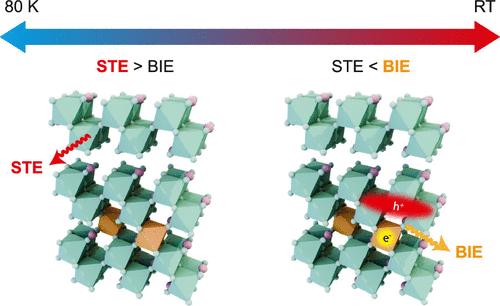Dynamic Behavior of Bound Interlayer Excitons in Interlayer-Doped Cs3Bi2Br9 Vacancy-Ordered Perovskite
IF 16
1区 材料科学
Q1 CHEMISTRY, MULTIDISCIPLINARY
引用次数: 0
Abstract
Interlayer doping of the vacancy-ordered 2D perovskite Cs3Bi2Br9 (CBB) enables the formation of bound interlayer excitons (BIEs), a unique charge-transfer excited state within the layered solid. BIEs previously reported with silver (Ag+) as an interlayer dopant exhibited bright broadband photoluminescence (PL) with prolonged lifetime at room temperature, offering potential applications in efficient white light emission, photocatalysis, and optoelectronics. However, the dynamic behavior of radiation and excited carriers remains poorly understood due to the limitations of ensemble spectroscopic measurements. Here, we investigate the temperature-dependent dynamics of Ag-doped Cs3Bi2Br9 (Ag-CBB) using single-particle time-resolved PL spectroscopy and ultrafast transient absorption imaging. Single-particle PL measurements reveal three distinct emission regimes across temperature: (i) BIE-dominant emission at high temperatures, (ii) a mixture of radiation from BIEs and self-trapped excitons (STEs) at intermediate temperatures, and (iii) STE-dominant emission below 100 K. Rapid transient absorption mapping using Parallel Rapid Imaging with Spectroscopic Mapping (PRISM) reveals subpicosecond STE formation in pristine CBB and long-lived photoinduced absorption by BIEs, consistent with electron–hole separation and suppressed STE transfer. The spatial uniformity of these signals confirms homogeneous Ag doping across single crystals. These findings highlight the role of Ag interlayer dopants in governing the BIE dynamics.

空位有序钙钛矿Cs3Bi2Br9层间掺杂层间激子的动力学行为
空位有序二维钙钛矿Cs3Bi2Br9 (CBB)的层间掺杂使层间激子(BIEs)形成,这是层状固体中独特的电荷转移激发态。先前报道的以银(Ag+)作为层间掺杂剂的铋在室温下表现出明亮的宽带光致发光(PL),寿命延长,在高效白光发射、光催化和光电子学方面具有潜在的应用前景。然而,由于系综光谱测量的限制,辐射和受激载流子的动力学行为仍然知之甚少。在这里,我们利用单粒子时间分辨PL光谱和超快瞬态吸收成像研究了ag掺杂Cs3Bi2Br9 (Ag-CBB)的温度依赖动力学。单粒子PL测量揭示了不同温度下三种不同的发射模式:(i)高温下以bie为主的发射,(ii)中温下bie和自俘获激子(STEs)的混合辐射,以及(iii) 100k以下以ste为主的发射。利用平行快速成像与光谱映射(PRISM)的快速瞬态吸收映射揭示了原始CBB中亚皮秒级的STE形成和长寿命的bie光诱导吸收,与电子空穴分离和抑制STE转移一致。这些信号的空间均匀性证实了银在单晶间的均匀掺杂。这些发现突出了银层间掺杂剂在控制BIE动力学中的作用。
本文章由计算机程序翻译,如有差异,请以英文原文为准。
求助全文
约1分钟内获得全文
求助全文
来源期刊

ACS Nano
工程技术-材料科学:综合
CiteScore
26.00
自引率
4.10%
发文量
1627
审稿时长
1.7 months
期刊介绍:
ACS Nano, published monthly, serves as an international forum for comprehensive articles on nanoscience and nanotechnology research at the intersections of chemistry, biology, materials science, physics, and engineering. The journal fosters communication among scientists in these communities, facilitating collaboration, new research opportunities, and advancements through discoveries. ACS Nano covers synthesis, assembly, characterization, theory, and simulation of nanostructures, nanobiotechnology, nanofabrication, methods and tools for nanoscience and nanotechnology, and self- and directed-assembly. Alongside original research articles, it offers thorough reviews, perspectives on cutting-edge research, and discussions envisioning the future of nanoscience and nanotechnology.
 求助内容:
求助内容: 应助结果提醒方式:
应助结果提醒方式:


